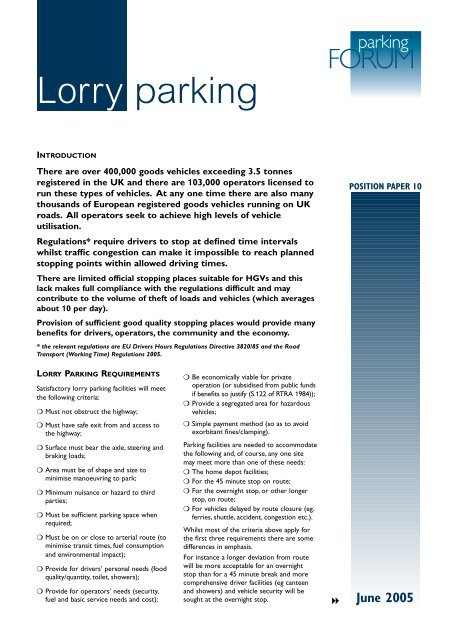Lorry parking
Lorry parking
Lorry parking
Create successful ePaper yourself
Turn your PDF publications into a flip-book with our unique Google optimized e-Paper software.
<strong>parking</strong>FORUM<strong>Lorry</strong> <strong>parking</strong>INTRODUCTIONThere are over 400,000 goods vehicles exceeding 3.5 tonnesregistered in the UK and there are 103,000 operators licensed torun these types of vehicles. At any one time there are also manythousands of European registered goods vehicles running on UKroads. All operators seek to achieve high levels of vehicleutilisation.POSITION PAPER 10Regulations* require drivers to stop at defined time intervalswhilst traffic congestion can make it impossible to reach plannedstopping points within allowed driving times.There are limited official stopping places suitable for HGVs and thislack makes full compliance with the regulations difficult and maycontribute to the volume of theft of loads and vehicles (which averagesabout 10 per day).Provision of sufficient good quality stopping places would provide manybenefits for drivers, operators, the community and the economy.* the relevant regulations are EU Drivers Hours Regulations Directive 3820/85 and the RoadTransport (Working Time) Regulations 2005.LORRY PARKING REQUIREMENTSSatisfactory lorry <strong>parking</strong> facilities will meetthe following criteria:❍ Must not obstruct the highway;❍ Be economically viable for privateoperation (or subsidised from public fundsif benefits so justify (S.122 of RTRA 1984));❍ Provide a segregated area for hazardousvehicles;❍ Must have safe exit from and access tothe highway;❍ Simple payment method (so as to avoidexorbitant fines/clamping).Parking facilities are needed to accommodatethe following and, of course, any one sitemay meet more than one of these needs:❍ The home depot facilities;❍ For the 45 minute stop on route;❍ For the overnight stop, or other longerstop, on route;❍ For vehicles delayed by route closure (eg.ferries, shuttle, accident, congestion etc.).Whilst most of the criteria above apply forthe first three requirements there are somedifferences in emphasis.For instance a longer deviation from routewill be more acceptable for an overnightstop than for a 45 minute break and morecomprehensive driver facilities (eg canteenand showers) and vehicle security will besought at the overnight stop.❍ Surface must bear the axle, steering andbraking loads;❍ Area must be of shape and size tominimise manoeuvring to park;❍ Minimum nuisance or hazard to thirdparties;❍ Must be sufficient <strong>parking</strong> space whenrequired;❍ Must be on or close to arterial route (tominimise transit times, fuel consumptionand environmental impact);❍ Provide for drivers’ personal needs (foodquality/quantity, toilet, showers);❍ Provide for operators’ needs (security,fuel and basic service needs and cost);June 2005
P A R K I N G F O R U M - P O S I T I O N P A P E R 1 0Operation ‘Stack’, which has been developedby Kent Police, is an example of control andmanagement of the rapid build up of HGVswhich arises when a major part of the routecloses.To date it has been operated with twophases according to the severity of the crosschannel delays. Phase1 can accommodate upto 800 HGVs whilst Phase 2 canaccommodate a further 3,000 HGVs. It isunderstood that Kent police and KentHighways are now reviewing the operation.AVAILABILITY OF AND DEMAND FORLORRY PARKINGCurrent researchThere is no single source of information onthe location and scope of all lorry <strong>parking</strong>facilities. Current availability of, and demandfor lorry <strong>parking</strong>, across England is beingresearched on behalf of the Highways Agency.A data base is being developed covering HGVflows (based on DfT and HA data), lorry<strong>parking</strong> facilities, driver needs and decisionmaking processes, operator requirements andthe interests of other stakeholders.Currently about 300 HGV <strong>parking</strong> facilitiesappear on the data base.These include 130motorway service areas (MSAs) and 170 otherfacilities. Many other unofficial andunauthorised locations are used for stopovers.Research is still ‘in process’ but earlyindications suggest that:❍ Overall there are insufficient facilities onthe network and there are considerableregional variations;❍ In the North West there are high HGVflows and good provision of <strong>parking</strong>facilities;❍ The North West is a node for many longdistance HGV flows (eg to and fromScotland, Ireland and Wales);❍ In the North East there are high HGV flowsand poor provision of <strong>parking</strong> facilities;❍ In Central London and the South Eastthere is very poor provision for lorry<strong>parking</strong> despite high vehicle through flowsto and from Europe.There is wide variation in demand by day ofthe week and time of day.The database will include information on thelocation, quality, facilities provided and pricesof lorry parks.MOTORWAY SERVICE AREASThese form an essential part of the ‘nationallorry park’ and are, by definition, well sited onthe major routes. However they have severalserious drawbacks for HGV drivers:❍ They are often full – and utilisation variesby time of day;❍ Security cover (eg CCTV ) is limited ornon existent;❍ Coaches also compete for space on theheavy vehicle areas;❍ Catering and showering facilities may notbe ideal.OTHER HGV PARKING FACILITIESHGV drivers generally prefer the facilitiesoffered by dedicated truck stops – but the‘offer’ at these does vary considerably. Valuedfeatures include:❍ Appropriate value for money menus;❍ Washing and toilet facilities;❍ Availability of fuel;❍ Security for vehicle (particularly whereloads are high value);❍ Closeness to route – 50% of drivers arewilling to deviate 2-5 miles and a few muchfurther;❍ Ability to use Truck Stops as an operationalbase – which is popular with some ownerdrivers.Operators often direct drivers as to wherethey should stop for reasons of security, costor route deviation. Others leave the driver tochose.The Safer Parking Scheme, which isincreasingly popular for car parks, is currentlybeing developed to identify and reward bestpractice in HGV <strong>parking</strong> facilities.THE COST OF PROVIDING PURPOSEBUILT TRUCK STOPSThe ideal locations for truck stops are also, bydefinition, ideal locations for distributioncentres.This means that land values are high.The construction of a large area of hardstanding with good quality services and propersecurity arrangements is also expensive.Thus creating a well sited quality truck stoprequires substantial capital investment and itcan only be a proper commercial venture if astrong and continuing income stream can beachieved.Indications suggest that many operators anddrivers are reluctant to pay more than aminimum for using Truck Stop facilities.Thushigh margins are not available and a highvolume of business will be necessary toachieve viability.
















